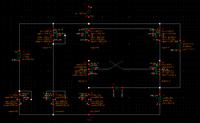viperpaki007
Full Member level 5

Hi,
I need to make a triangular waveform generator at 2.5MHz with 0 and 1.2V positive and negative voltages. Most of the circuits which i see in literature are made from opamp integrator. I don't want to use opamp integrator circuit because they use resistor to control triangle waveform ramp and it is quite hard to make precise resistors on IC. Can somebody suggest a triangular waveform generator suitable for IC implementation.
regards
I need to make a triangular waveform generator at 2.5MHz with 0 and 1.2V positive and negative voltages. Most of the circuits which i see in literature are made from opamp integrator. I don't want to use opamp integrator circuit because they use resistor to control triangle waveform ramp and it is quite hard to make precise resistors on IC. Can somebody suggest a triangular waveform generator suitable for IC implementation.
regards







